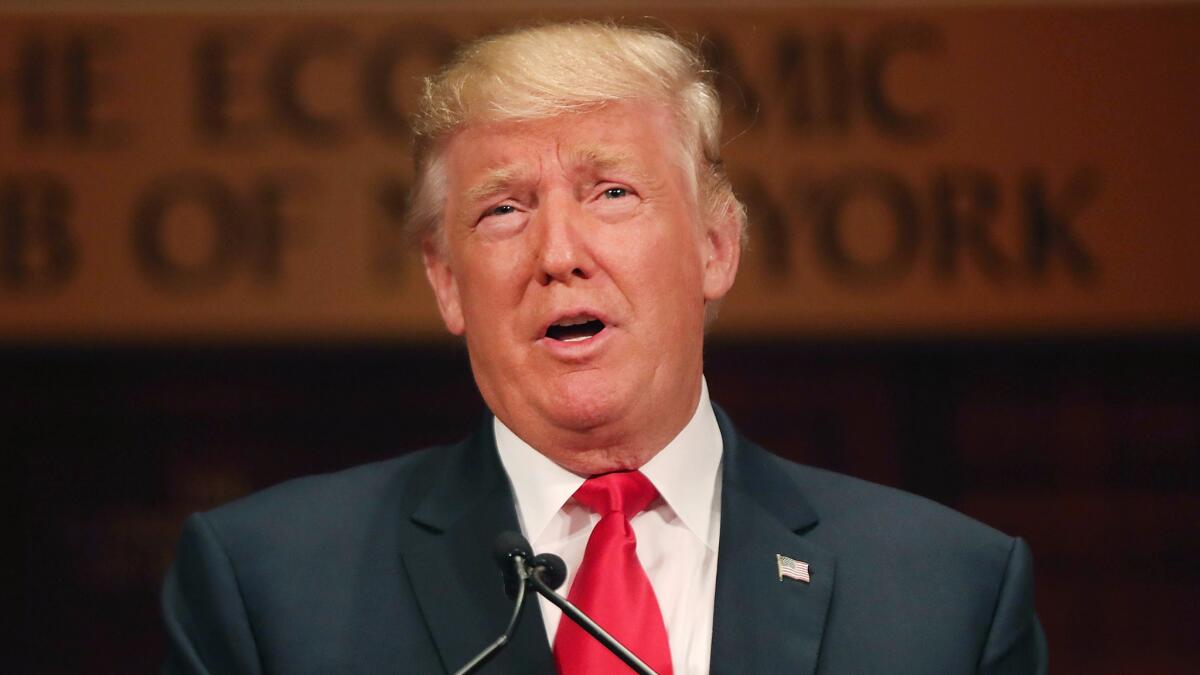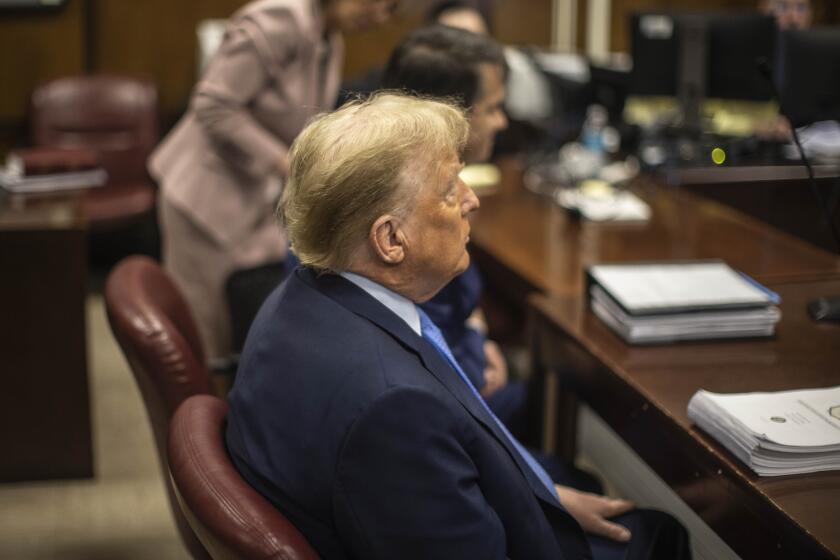Donald Trump revises his economic plan but leaves many questions unanswered

Donald Trump scaled back his grandiose plan for tax cuts while proposing more benefits for lower-income households in a speech Thursday, but experts say the numbers in his newly revised economic growth blueprint still don’t add up.
In his most detailed economic plan to date, the Republican presidential nominee essentially halved the amount of tax cuts he will seek to $4.4 trillion over 10 years, in part by capping deductions. At the same time, Trump said his economic strategy — which includes overhauling government regulations, trade and energy policies — would boost U.S. economic growth to 3.5% a year on average, up from 2% in recent years. He promised that his plan would create as many as 25 million jobs over the next decade.
“This is the most pro-growth, pro-jobs, pro-family plan put forth perhaps in the history of our country,” he said in a speech at the Economic Club of New York.
While responding to critics that his previous tax and growth plans were vague and unrealistic, Trump nonetheless raised questions about how he could achieve such rapid economic growth — former candidate Jeb Bush was derided for promising 4% growth — and pay for what are still very large tax cuts to individuals and businesses.
Election 2016 | Live coverage on Trail Guide | Sign up for the newsletter | The race to 270
“It’s still very pie-in-the-sky,” said Marc Goldwein, senior vice president for the Committee for a Responsible Federal Budget, a nonpartisan group that advocates keeping government budgets under control.
Trump’s plan would reduce the tax brackets for individual income tax to three from the current seven, with the highest rate dropping to 33% from 39.6%. Deductions would be limited at $100,000 for single filers and $200,000 for married filers, which would restrain high-income filers looking to deduct more for housing and charitable donations.
In attempting to appeal to lower- and middle-income Americans, Trump called for an expanded earned income tax credit and tax savings for child-care expenses.
In addition, it appeared that sole proprietorships, partners and other so-called pass-through entities, who tend to be used by higher-income filers, would not be able to take advantage of Trump’s plan lowering the corporate tax rate to 15% from the current 35%, said Howard Gleckman, a senior fellow at the Tax Policy Center. Trump’s speech and additional details released by his campaign did not make it clear.
“This proposal is less skewed toward the high-income” earners, said Gleckman. Still, he said, the lowering of tax rates, plus Trump’s previously announced idea to repeal the estate tax and alternative minimum tax, would nonetheless still end up disproportionately benefiting higher-earning individuals.
Although Trump’s plan would cut taxes overall by $4.4 trillion over 10 years, he said that the lost federal revenue would amount to about $2.6 trillion under a so-called dynamic growth model, which assumes that the tax cuts would stimulate growth and thus generate additional revenues. By its calculations, Trump’s economic team would make up for about $1.8 trillion of the $2.6 trillion deficit largely by negotiating more favorable trade deals, reforming energy policies and eliminating costly government regulations.
The remaining deficit would be shaved by reducing government spending, although Trump said there would be no reduction in defense and Social Security, Medicare and Medicaid, which together make up about three-quarters of the federal budget.
Taken together, said Peter Navarro, a UC Irvine professor and Trump economic advisor, “it’s really not a stretch at all” to return the nation’s annual economic growth to the historical average of 3.5% from the end of World War II through 2000.
“It’s a fairly simple walk to 3.5%,” he said Thursday from New York, where he joined Trump for his speech.
But other economists, conservative and liberal, are much more circumspect that Trump’s plan could achieve such rapid growth.
“If he could go from 2 to 3, that would be amazing; he’d be in the hall of fame,” said Douglas Holtz-Eakin, president of the right-leaning American Action Forum.
The challenge for Trump is that economic growth is essentially a function of the number of workers and the rate of productivity growth, and both have lagged in the last decade as the population has aged and the increase in labor force has shrunk and productivity has sagged. Greater business investment and higher wages will help lift both measures, but many other economists believe Trump’s tough trade promises — to renegotiate the trade agreement with Canada and Mexico, and threats to impose big tariffs on China and other trading partners — will hurt global trade and end up subtracting from U.S. economic output growth.
“It’s fair to say that he has a fairly pro-growth policy to take growth north of 2%,” Holtz-Eakin said. “The trouble is, he’s over-counting what he could get. … They’re seriously responding to the critique and now they’re claiming it adds up — I don’t think it does.”
Mark Zandi, chief economist at Moody’s Analytics, said that perhaps the best way to boost economic growth would be to increase legal immigration, which would increase the labor force and productivity, as immigrants tend to start businesses at a greater rate than native-born Americans. But that’s simply not an option in a Trump presidency, Zandi noted, referring to Trump’s hard-line stance on the issue, the signature of his campaign. “He’s no fan of immigration.”
Hillary Clinton’s campaign attacked Trump’s plan as a benefit for him, not for workers.
“It is astounding that Donald Trump doubled down on his tax plan benefiting billionaires while he continues to refuse to release his own tax returns that would reveal just how much he’d be impacted by his own plan,” said Clinton senior policy advisor Jacob Leibenluft. “Trump’s latest revision of his economic plan would benefit Trump at the expense of millions of hardworking folks across our country who deserve the opportunity at a better future.”
Twitter: @noahbierman, @dleelatimes
‘Believe me’: People say Trump’s language is affecting political discourse ‘bigly’
Trump and Clinton both release some medical details amid scrutiny over their health
More to Read
Get the L.A. Times Politics newsletter
Deeply reported insights into legislation, politics and policy from Sacramento, Washington and beyond. In your inbox three times per week.
You may occasionally receive promotional content from the Los Angeles Times.








